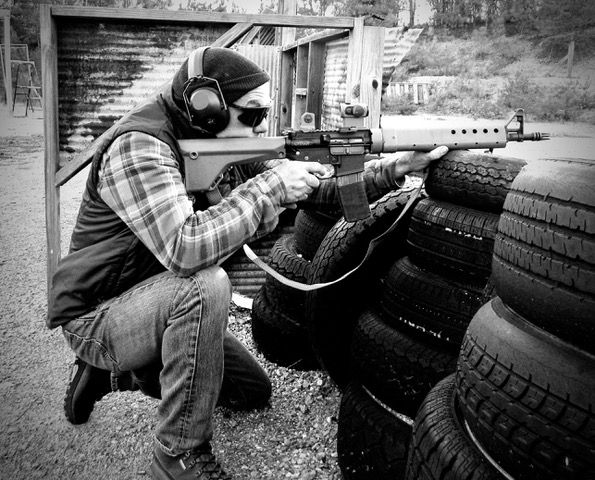Editor’s note: When working from downed/disabled positions live fire on a range, look out for the angle at which rounds approach and exit the target; if you’re close, you’ll potentially put rounds over the backstop. As an alternative, working close, use airsoft or lower the targets to ensure a safe backstop, per RULE 4.

One of the big advantages of fighting with firearms is the ability to move while still putting hits on the threat. It’s usually better to stay on your feet while fighting so you can move. But there are times you’re forced to fight from a position other than standing. When this happens it’s far better to have practiced in advance.
Fights at danger close -- arm’s reach distance -- often end up on the ground. The attacker lands a smashing right hook into the side of your head; pushes you down or tackles you from behind. Maybe, and we see this happen on the range so you know it occurs in fight, you trip over your own feet. Regardless of the reason you why -- you ended up on the ground and you don’t want to stay down.
Train in “grounded drills,” using the gun to fight your way up to standing from a downed position on your stomach, back, sideways. You practice how to safely draw the pistol from these positions, without sweeping or covering yourself or others. Working with a dummy weapon on the carpet in the den is the best way to learn these skills, but only after receiving instruction on the proper techniques.
The fight may begin while you’re sitting. You’re at a desk, a table at the diner or maybe sitting inside a car. The situation requires you to draw while seated, another skill that needs to be practiced for efficiency but also for safety. Because of restricted movement – it might not be a good idea to telegraph what you’re doing - move the feet and legs out of the way of the muzzle as you draw.
It may be necessary to get lower to take advantage of cover. In most defensive situations it’s important to use positions that are quick to get into -- and equally important, easy to get out of. Usually this means working from a kneeling position. The “speed” or “unbraced” kneel is simply dropping down onto the strong side knee. In “braced” kneeling the support elbow is resting on the support knee. There’s the “double” kneeling position; you drop down onto both knees. This works well for leaning out to both strong and support sides of cover. While discovering which positions work best, you’re also learning what doesn’t work for you, which changes as you age.
Regardless of where you’re fighting from, your position must be stable. When moving from one position to another, for example from kneeling to standing, keep the muzzle pointing in the appropriate location and finger off the trigger. Whenever possible make sure to scan as you change positions; each one gives you a different view of the world.
Learn these techniques and skills in advance, as opposed to attempting to acquire new skills during the fight – which is difficult if not impossible. As they say the devil is in the details. Sure, things probably won’t go as planned. No problem. A good grounding in these fundamentals will allow you to improvise as necessary.
Tiger McKee is director of Shootrite Firearms Academy. He is the author of The Book of Two Guns, AR-15 Skills and Drills, has a regular column in American Handgunner and makes some cool knives and custom revolvers. Visit Shootrite’s Facebook page for other details.